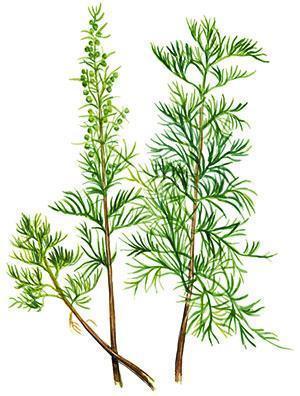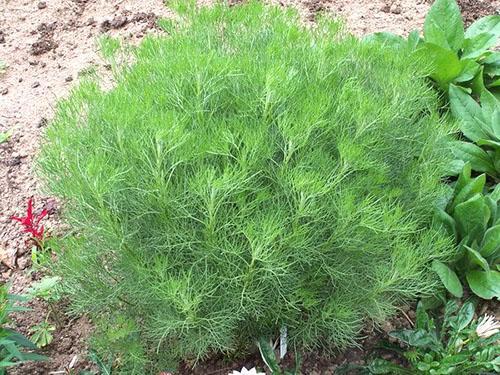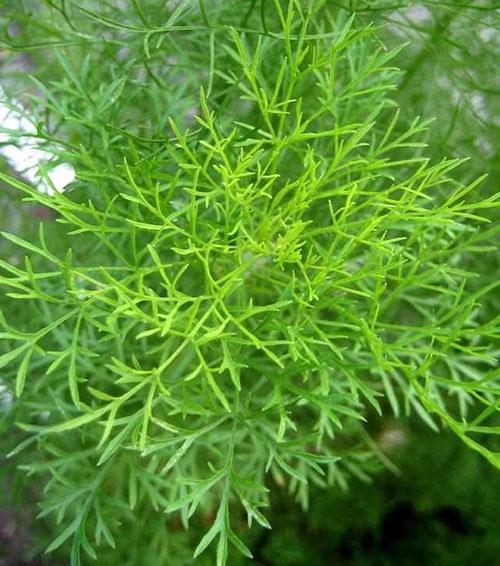Photo of a dill tree and growing rules on your site
 When the dill tree is mentioned, the imagination involuntarily draws the image of a giant umbrella plant with fragrant feathery foliage.
When the dill tree is mentioned, the imagination involuntarily draws the image of a giant umbrella plant with fragrant feathery foliage.
Indeed, this culture, which has culinary, decorative and medicinal value, has openwork repeatedly dissected greens, but it has no medicinal relation to the usual garden dill Artemisia abrotanum or wormwood.
The description of the process of growing a dill tree and its photos are not as common as materials about the agricultural technology of ordinary dill, but the appearance and properties of the culture are no less interesting. Among more than a hundred varieties of wormwood, the dill or god tree, as the plant is popularly called, is distinguished not only by the type of leaves, but also by the fact that it is practically a perennial shrub. Powerful stems of medicinal wormwood, reaching a height of one and a half, and in the southern regions and two meters, already lignified by the second or third, and a thick branching rhizome allows nourishing a vast crown, up to 1 meter in diameter.
Read about the tulip tree!
Dill tree: photo and description of medicinal, spice-flavoring and decorative culture

It is interesting that the wild dill tree is found in the southern regions of the country, for example, on the Black Sea coast of the Caucasus, as well as in the southwest of Siberia.
 Despite its southern origin and thermophilic nature, wormwood is quite unpretentious, and a dill tree can be grown in almost any area. The vegetation of this type of wormwood begins in the last week of April or early May, and after a month the plant forms a beautiful openwork crown, which can be easily formed if necessary.
Despite its southern origin and thermophilic nature, wormwood is quite unpretentious, and a dill tree can be grown in almost any area. The vegetation of this type of wormwood begins in the last week of April or early May, and after a month the plant forms a beautiful openwork crown, which can be easily formed if necessary.
 Today, gardeners have varieties of dill at their disposal, as in the photo, with bright green foliage and with silvery leaves, more traditional for wormwood. Flowering of this species begins 70–140 days after the appearance of greenery, therefore, in the conditions of the middle lane, it is not always possible to see paniculate inflorescences consisting of rounded whitish or yellowish flowers.
Today, gardeners have varieties of dill at their disposal, as in the photo, with bright green foliage and with silvery leaves, more traditional for wormwood. Flowering of this species begins 70–140 days after the appearance of greenery, therefore, in the conditions of the middle lane, it is not always possible to see paniculate inflorescences consisting of rounded whitish or yellowish flowers.
The seeds of medicinal wormwood either do not have time to set or do not ripen.
Dill tree propagation and planting methods
 If other related species easily propagate by root cuttings, then the rhizome of the dill tree does not give such shoots, but the bush is easily cuttings, plants can be divided, and viable cuttings can be obtained from above-ground shoots.
If other related species easily propagate by root cuttings, then the rhizome of the dill tree does not give such shoots, but the bush is easily cuttings, plants can be divided, and viable cuttings can be obtained from above-ground shoots.
When, in the second half of June, young branches of the dill tree begin to harden:
- cuttings are cut from 10 to 15 cm long, with 3-4 internodes;
- for a day, planting material is immersed by 1.5–2 cm in a root or heteroauxin to stimulate root formation and growth;
- the cuttings are washed and planted in a mixture of one part of humus and two parts of sand, deepening by 2-3 cm.
 Young plants should be covered for up to 6 weeks.At this time, a container with rooting cuttings of a dill tree is regularly watered and monitored to prevent decay of the shoots. In the second half of August, seedlings with a formed root system are transplanted into open ground. Usually, by the onset of cold weather, the dill tree, in the photo, is fully acclimatized and has time to grow up to 40-50 cm in height.
Young plants should be covered for up to 6 weeks.At this time, a container with rooting cuttings of a dill tree is regularly watered and monitored to prevent decay of the shoots. In the second half of August, seedlings with a formed root system are transplanted into open ground. Usually, by the onset of cold weather, the dill tree, in the photo, is fully acclimatized and has time to grow up to 40-50 cm in height.
If the planting material was harvested in the second half of summer, then it is better not to transfer the seedlings to the garden, but to leave them for the winter on a cool terrace or even in a room. In cold wintering conditions, plants are watered no more than 1 time in 7–10 days, while medicinal wormwood usually sheds almost all the foliage, vegetation stops, and buds form at the attachment points of the lateral leaves, which will start growing in spring. Similarly, you can propagate a bush of medicinal wormwood using aboveground layering, for which the shoots are tilted to the soil, pinned to the ground and sprinkled.
If there is already a dill tree on the site, small parts with 3-4 branches and a sufficiently developed rhizome can be separated from an adult bush with a shovel.
 If the gardener was able to get small seeds of this unusual plant, then a dill tree can be grown from them only through seedlings. When a dill tree is grown as an indoor crop, a fast-growing shrub is necessarily cut off and actively fed, because a young plant can form up to 20 shoots of 75 cm in length per season.
If the gardener was able to get small seeds of this unusual plant, then a dill tree can be grown from them only through seedlings. When a dill tree is grown as an indoor crop, a fast-growing shrub is necessarily cut off and actively fed, because a young plant can form up to 20 shoots of 75 cm in length per season.
Selection of a site for growing a dill tree
 The area where medicinal or, as European gardeners say, shrubby wormwood will grow, should be well lit, but protected from the wind. The soil for planting a dill tree should be loose, sufficiently nutritious and neutral.
The area where medicinal or, as European gardeners say, shrubby wormwood will grow, should be well lit, but protected from the wind. The soil for planting a dill tree should be loose, sufficiently nutritious and neutral.
If the soil:
- has an acidic reaction, lime or dolomite flour must be added;
- poor in nutrients, digging is carried out with the introduction of well-rotted organic matter;
- excessively dense, must be applied peat and sand.
It is best to plant a dill tree on the south side of a fence, high perennial vegetation or building, so that the shrub receives enough light and heat without being attacked by the cold wind.
In this case, a culture that can withstand frosts down to –25 ° C can winter without additional shelters. And if the young tops of the shoots are damaged, then during the summer period the dill tree will grow well and quickly compensate for the losses.
How to fertilize a dill tree, and how to care for a crop?
 The plant responds well to feeding and growing on fertile soil, therefore, before planting a dill tree, for each square meter of soil, they are introduced:
The plant responds well to feeding and growing on fertile soil, therefore, before planting a dill tree, for each square meter of soil, they are introduced:
- 6 kg organic fertilizers;
- 15 grams of ammonium nitrate and potassium chloride;
- about 30 grams of superphosphate.
In order for the bush to have room to grow, young wormwood is planted at a distance of at least a meter from neighboring plants, except for cases when the dill tree, as in the photo, is used to organize live green borders. Here the distance is halved and the formation of the crown and the growth of new shoots are closely monitored.
During the acclimatization period, the plants are actively watered. Adult bushes of medicinal wormwood can easily tolerate dry periods, but do not tolerate excessive soil moisture. The soil under the dill tree is loosened, freed from weeds and fallen leaves, and they also do not forget to fertilize the dill tree, which in spring and in the second half of summer needs mineral fertilizing, and organic matter for plants is brought in in the fall.
Useful properties and application of dill tree greens
 Usually, this culture is almost not interested in pests, so growing a dill tree will not cause trouble even for beginners.But the bushes reaching 10 years of age will become a good source of greenery, rich not only in essential oils that give the foliage the aroma of fresh dill, notes of camphor, citrus fruits and even needles, but also natural bitterness, coumarins, flavonoids, tannins and minerals, and vitamins.
Usually, this culture is almost not interested in pests, so growing a dill tree will not cause trouble even for beginners.But the bushes reaching 10 years of age will become a good source of greenery, rich not only in essential oils that give the foliage the aroma of fresh dill, notes of camphor, citrus fruits and even needles, but also natural bitterness, coumarins, flavonoids, tannins and minerals, and vitamins.
For culinary and medicinal purposes, the upper parts of the shoots and young foliage of the dill tree are used, in the photo, the richest in active substances.
The plant raw material of the dill tree in folk medicine is used as a remedy for anemia, parasitic infestations and pains of various natures, greens are used as a remedy for sprains and bruises, inflammatory processes and disorders of the nervous system. In Germany, where the dill tree is grown along with the usual spicy herbs, fresh and dried foliage is added to meat and game dishes, to sauces and soups. Wormwood greens are also good in marinades, baked goods, vegetable and mushroom pickles. On the shoots and leaves of medicinal wormwood, alcohol tinctures are made and tea is brewed.
 The aroma, similar to the smell of dill, is retained only in young leaves, then it becomes more saturated, and the true tones of wormwood already prevail in it. When using this plant for food, it is important to remember that it, like all types of wormwood, contains alkaloids and in excessive quantities can cause health problems.
The aroma, similar to the smell of dill, is retained only in young leaves, then it becomes more saturated, and the true tones of wormwood already prevail in it. When using this plant for food, it is important to remember that it, like all types of wormwood, contains alkaloids and in excessive quantities can cause health problems.
It is very interesting and informative to learn about such wormwood. As I understand it, this plant loves a mild climate, so it does not occur in Eastern Siberia. It would be nice to use bushes in landscaping. The main thing is unpretentious, and even its phytoncides would be protection for other plantings. I made a memo in my workbook. I will try to grow it as a balcony plant.